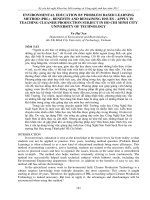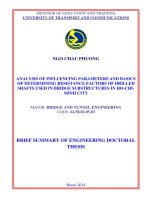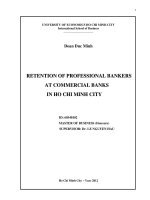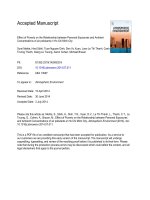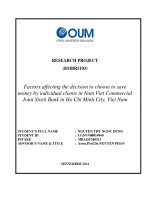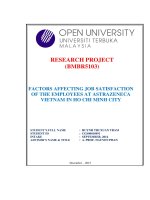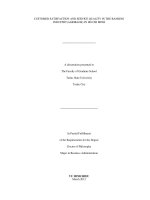Money laundering awareness and preventing at commercial banking system in ho chi minh city
Bạn đang xem bản rút gọn của tài liệu. Xem và tải ngay bản đầy đủ của tài liệu tại đây (740.89 KB, 123 trang )
MINISTRY OF EDUCATION AND TRAINING
UNIVERSITY OF ECONOMICS HO CHI MINH CITY
CHUNG PHỐI DIỆU
MONEY LAUNDERING – AWARENESS AND
PREVENTING AT COMMERCIAL BANKING
SYSTEM IN HO CHI MINH CITY
MASTER THESIS
Faculty of Banking
Ho Chi Minh City – 2011
2011
MINISTRY OF EDUCATION AND TRAINING
UNIVERSITY OF ECONOMICS HO CHI MINH CITY
CHUNG PHỐI DIỆU
MONEY LAUNDERING – AWARENESS AND
PREVENTING AT COMMERCIAL BANKING
SYSTEM IN HO CHI MINH CITY
MAJOR: BANKING AND FINANCE
MAJOR CODE: 60.31.12
MASTER THESIS
SUPERVISOR
HỒ VIẾT TIẾN Ph.D.
Faculty of Banking
Ho Chi Minh City
2011
CERTIFICATE
I assure that the contents and figures in this research are from my study and
performance and have been properly quoting.
The writer
Chung Phoi Dieu
TABLE OF CONTENT
ABSTRACT
ACKNOWLEDGE
ABBREVIATION
LIST OF TABLES
Chapter 1. Introduction to the study .........................................................................1
1.1
Rationale of the study:...................................................................................1
1.2
Statement of the problem:..............................................................................2
1.3
Research questions: .......................................................................................2
1.4
Research objectives: ......................................................................................3
1.5
Scope and limitation of the study: .................................................................3
1.5.1
Scope:......................................................................................................3
1.5.2
Limitation: ..............................................................................................4
1.6
Methodology of the study:.............................................................................4
1.7
Structure of the study:....................................................................................5
Chapter 2. Overview of Money laundering (ML) and Anti Money laundering
(AML)
2.1
.................................................................................................................7
Basic information about ML: ........................................................................7
2.1.1
Definition of ML: ....................................................................................7
2.1.2
The cycle of ML.......................................................................................8
2.1.3
The impact of ML and the importance of AML: ...................................10
2.1.4
Examples of suspicious transactions:...................................................12
2.2
The worldwide experience on enforcement of AML: .................................13
2.2.1
Some typical organizations set up and promote standards on AML:..13
2.2.2
The AML enforcement in some countries: ............................................19
Chapter 3. Research Methodology .........................................................................23
3.1
Research design: ..........................................................................................23
3.2
Data sources and collection .........................................................................25
3.2.1
The secondary data:..............................................................................25
3.2.2
The primary data: .................................................................................26
3.3
Data analysis and presentation: ...................................................................29
Chapter 4. The current awareness and preventing on ML at commercial banks in
HCMC
4.1
...............................................................................................................33
Overview of ML and AML in Vietnam banking system: ...........................33
4.1.1
Overview of legal framework of ML and AML on Vietnam banking
system: ...............................................................................................................33
4.1.2
Overview of commercial banking system in HCMC: ...........................37
4.1.3
ML & AML in Vietnam banking system in general: .............................39
4.2
The necessary of AML in Vietnam: ............................................................41
4.3
The achievement of AML in banking sector:..............................................43
4.3.1
Legal system: ........................................................................................43
4.3.2
Government management and monitoring of ML and AML: ...............43
4.3.3
Methods of AML: ..................................................................................43
4.3.4
AML international cooperation:...........................................................44
4.4
The main constraints of ML and AML in Vietnam banking sector: ..........44
4.4.1
Largely cash-based economy: ..............................................................44
4.4.2
Deficiency of ML and AML law and regulations: ................................45
4.4.3
ML and AML - new concept to Vietnam:.............................................45
4.4.4
The competition between banks:...........................................................46
4.4.5
The inconsistence implementation of ML and AML procedures between
banks: ...............................................................................................................47
4.4.6
Lack of the on site inspection undertaken to date by financial
supervisors: ........................................................................................................48
4.4.7
4.5
Lack of the information exchanging with international departments: .49
The evaluation of awareness and preventing ML at commercial banks in
HCMC:...................................................................................................................49
4.5.1
Hypothesis testing results: ....................................................................49
4.5.2
The AML policy and AML department in each sector: ........................54
4.5.3
The current training in each sector: .....................................................55
Chapter 5. The implications for the banking systems on ML & AML ..................58
5.1
Macro implications:.....................................................................................58
5.1.1
Improving the legal framework on ML and AML in Vietnam: .............58
5.1.2
Popularizing and promoting the knowledge of ML and AML to the
public: ...............................................................................................................59
5.1.3
Establishing the closely and prudently monitoring:.............................60
5.1.4
Enhancing international relationship to corporate to international
AML:
...............................................................................................................62
5.2
Micro implications:......................................................................................62
5.2.1
Learning and sharing experience between commercial banks lead by
SBV:
...............................................................................................................62
5.2.2
Establishing and strengthening the missions of AML department:......63
5.2.3
Popularizing and enforcing the AML policies and procedures in each
bank:
...............................................................................................................63
5.2.4
Conducting on-going training to staffs: ...............................................68
CONCLUSION .........................................................................................................70
REFERENCE............................................................................................................71
APPENDIX
ABSTRACT
WÕX
Nowadays, people in the world gradually recognize that there is serious risks
exist when the criminal activity that involves crime money is transferred or
“laundered” successfully to become the legitimate fund. It could bring to large
threat to the economy as such huge “legitimate” fund which in turn could control
again the economy. Especially, banking system may be one of the place for these
money laundering activities to be happened easily incase there are loose of
controlling and vigilance for this risk. The need for enhancing the anti money
laundering regime and made the international financial systems transparency and
integrity is more important than ever to ensure and limit the public funds mobilized
will not be the laundered or criminal funds or the banks will not be used for money
laundering.
As a part in the global economy integration and global financial systems,
Vietnam is also under the trend to build the fence to prevent for the money
laundering. We are here to assess for the current situation of the money laundering
and anti money laundering regime in Vietnam commercial banking sector in order
to find out for any implications to improve the current regime to be as strong as we
could. Of course, the effective way is to give rise to banks and personal
responsibility. To detect, prevent ML and protect the financial community, every
financial institution and every employee in the financial sector has a role to play.
ACKNOWLEDGE
WÕX
Firstly, I would like to express my deep and sincere appreciation to my
research Supervisor, Dr. Ho Viet Tien for his valuable guidance and comments as
well as his experience sharing and encouragements throughout my research course.
I would like to thank to the banking experts from commercial banks in Ho Chi Minh
City who are enthusiasm and helpful to share their knowledgeable opinions and
experience. Moreover, the gratitude is also addressed to all of the banking staffs,
banking friends and classmates who fervently participated in the survey. Last but
not least, my special appreciation is extended to all instructors at Faculty of
Banking and Postgraduate Faculty, University of Economics Ho Chi Minh City for
their precious coaching and supporting during my study.
Once again, thanks for all my beloveds for your ceaseless support to
complete this research.
ABBREVIATION
AML
Anti – Money Laundering
AMLIC
Anti-Money Laundering Information Center
APG
Asia Pacific Group
CDD
Customer Due Diligence
CFATF
Caribbean Financial Action Task Force
EAG
Eurasian Group on Combating Money Laundering and
Financing of Terrorism
ESAAMLG
Eastern and South African Anti Money Laundering Group
FinCEN
Financial Crimes Enforcement Network
FIUs
Financial Intelligent Units
FSRBS
FATF-style regional bodies
GAFISUD
Financial Action Task Force on Money Laundering in South
America
GIABA
Inter-Governmental Action Group against Money Laundering
in West Africa
HCMC
Ho Chi Minh City
KYC
Know Your Customer
MENAFATF
Middle East and North Africa Financial Action Task Force
ML
Money laundering
ODCCP
Office for Drug Control and Crime Prevention
PEPs
Politically Exposed Persons
SBV
State bank of Viet Nam
UN
United Nations
UNODC
United Nations Office on Drugs and Crime
LIST OF TABLES
Table 3-1 – Formula of measurement .............................................................................................. 31
Table 4-1 – Network of commercial banks in HCMC ..................................................................... 38
Table 4-2 – The suspicious transactions report................................................................................ 41
Table 4-3 – The statistical data of question 9 .................................................................................. 51
Table 4-4 – Frequency thinking of ML and AML of staffs ............................................................. 53
Table 4-5 – AML policy and department in each sector.................................................................. 54
Table 4-6 – The sources of ML and AML knowledge..................................................................... 55
Table 4-7 – Actions taken by staffs.................................................................................................. 56
1
Chapter 1. Introduction to the study
----------------------------------------------------------------------------------------------------1.1 Rationale of the study:
Drugs / arms trafficking, corruptions, smugglings etc “generate” huge
monetary value every year. The criminal would find the way to “clean” these illicit
funds to be the legal sources as from the legitimate business activities for their own
using. This cleaning process is known as money laundering. Gradually, money
laundering (ML) and anti money laundering (AML) became a global issue as its
wide range affect on economic, finance, politic as well as society of not only within
a country but also worldwide stability. Especially the banking system is constantly
under the threat from these laundering processes.
Most countries now have AML measures in place and these laws, regulations
give rise to corporate and personal responsibility. Currently there are 34 countries
became members of Financial Action Task Force on Money Laundering (FATF), an
intergovernmental body whose purpose is to develop and promote an international
response to combat money laundering.
Vietnam is also became a member of Asia Pacific Group (APG) on Money
Laundering in 2007 and is on the way to develop their laws and enforcement on this
global issue to comport with international standards. Due to the habit of using cash
as well as the increasing of the trade and investment, Vietnam has been labeled as
the site of significant money laundering activities by the United Nations Office on
Drugs and Crime (UNODC). Almost all trade, investment, cash in transactions are
not monitored effectively at our banking system due to ML and AML is still a new
concept in many people’s mind in Vietnam. The banking system could be used for
money laundering.
Therefore, the faster and effectiveness Vietnam banking system upgrade the
regime of ML and preventing ML, the less the crimes are disguised to legitimate
2
business through this channel. The awareness of the bank staffs on AML plays an
important role in preventing the service provided by the bank from being used for
illicit activities. The banking staffs needs to be vigilant at all time to protect the
reputation as well as the customers of the bank and to meet the legal and moral
obligations.
1.2 Statement of the problem:
Well awareness of AML will help to reduce the possibility of the money
launderers to legalize their crime funds. This thesis will conduct an assess on the
understanding and awareness of banking staffs (between Vietnamese commercial
banks and foreign banks in Vietnam) on ML and preventing ML in order to know
the current situation of this issue in our banking system; address the main
achievements and practical constraints and to find out the implications in order to
take additional steps necessary to establish the strong AML regime in Vietnam
banking system.
1.3 Research questions:
With the above research statement, the study will answer the following
questions:
-
What are ML and why Vietnam banking system needs to prevent ML?
-
What are the current situations of ML & AML in Vietnam banking system?
What are the main achievement and practical constraints of ML & AML in
Vietnam banking system?
-
What are the current understanding and awareness of ML and preventing of ML
between foreign bank and Vietnamese commercial bank staffs? Are there
differences AML practices between these two sectors (hypothesis testing)?
-
What are the implications for the regime of ML & AML in Vietnam banking
system?
3
1.4 Research objectives:
Researching the problem and answering the above research questions will aim to
-
To gain the knowledge of ML & AML in general.
-
To approach the current practices of ML & AML in Vietnam banking system.
-
To assess the understanding and awareness between Vietnamese commercial
bank and foreign bank staffs in ML & AML.
-
To figure out the implications to improve and establish the strong knowledge
and regime of ML & AML in Vietnam banking system.
1.5 Scope and limitation of the study:
1.5.1 Scope:
As mentioned above, this study will research the awareness and prevention
of ML at commercial banks in Vietnam through two main sectors of banking system
that is Vietnamese commercial banks and foreign banks in Vietnam. Vietnamese
commercial banks sector included three Vietnamese state-owned commercial banks
and eight Vietnamese joint-stock commercial banks. Foreign banks in Vietnam
sector included four 100% foreign-owned banks, six branches of foreign banks
(details see appendix 1). We excluded the joint venture bank in this research.
The reason for choosing these typical banks for research is due to their large
charter capital and their widest network compared to each sector’s individual banks
(details of charter capital and network of the above individual banks see appendix
1).
We conduct the research on the case study at Ho Chi Minh City (HCMC) of
Vietnam. The research will be conducted through the random banking staffs in the
head offices, main transaction offices, branches, transaction offices, transaction
points and representative offices at HCMC of the choosing banks.
4
1.5.2 Limitation:
By end of October 2011, there are approximate 44 banks in Vietnamese
commercial banks sector and 63 banks in foreign banks sector1 (excluded 5 joint
venture banks) and thousand of their head offices, main transaction offices,
branches, transaction offices, transaction points and representative offices across
Vietnam. Due to the limitation of time and resources of author, the sample of the
study is not large enough to cover all banks’ banking staffs in Vietnam on ML &
AML understanding; it is proposed to cover some typical banks as mentioned above
in two sectors with a sample of 120 staffs. Together with the ML transactions are
diversified with sophisticated disguise. The knowledge of the ML & AML needs to
be updated day by day to cover all tricky of the launderers. The above constrains
will be continuously researched and completed by other studies.
1.6 Methodology of the study:
The data collection used in the research will be the secondary data and the
primary data from in-depth interviewing and survey conducting. The sources of the
secondary data will be Internet, Newspaper, Periodical Magazines, Articles, Law
and regulations etc…The primary data will be the in-depth interviews from banking
experts who works for both above two sectors and the mass sample survey (120
staffs from different choosing Vietnam commercial banks and foreign banks in
HCMC of Vietnam). The survey research approach will come out with the null
hypothesis H0 and the alternative hypothesis H1 as below
+ H0: There is no difference in the awareness and prevention of ML between
Vietnamese commercial banks and foreign banks in HCMC.
+ H1: There is difference in the awareness and prevention of ML between
Vietnamese commercial banks and foreign banks in HCMC.
Data analysis will be developed thereafter to test for the above hypothesis.
1
State Bank of Vietnam’s bank network report
5
1.7 Structure of the study:
Chapter 1 – Introduction to the study
This chapter is mainly stated the rationale of the study, the problem
statement, the research questions and objectives, the scope and limitation, the
methodology and the structure of the study.
Chapter 2 – Overview on ML & AML
This chapter is a review of some academic information which is applied for
analysis throughout the research included the concept of ML & AML, the impact of
ML and the importance of AML, the example of suspicious transactions, the
regulations on ML & AML worldwide, the experience and regime of ML & AML
in some countries.
Chapter 3 – Research methodology
The chapter is to describe, justify the research methodology used in the
study. With the research problem mentioned in chapter 1 which is identified by the
first draft of exploratory research, the researcher established the research design,
conducted data collection and data analysis to solve the research problem.
Chapter 4 – The current awareness and preventing on ML at commercial banks in
HCMC.
This chapter goes through the overview of legal system of ML and AML in
Vietnam and the overview of commercial banking in HCMC; presents descriptive
findings from international AML organization about ML & AML of Vietnam in
general; discusses the necessary of AML in Vietnam and the main achievements
and constrains in ML and AML in Vietnam; analyses the opinions and experience
from banking experts of commercial banks in HCMC and the results from the
testing of the hypothesis with regarding to the current awareness on ML & AML of
banking staffs between Vietnam commercial banks and foreign banks in HCMC.
6
Chapter 5 - The implications for the banking systems on ML & AML
Through the research results from chapter 4, this chapter is aim to provides
the implications for improving the current situation on ML & AML of both
Vietnamese commercial banks and foreign banks in Vietnam.
7
Chapter 2. Overview of Money laundering (ML) and Anti Money laundering
(AML)
---------------------------------------------------------------------------------------------------In this chapter we will go through some basic information of ML and AML
from the definition to the cycle of ML, the example of suspicious transactions of
ML to the legal framework, AML organization and the experience of AML in the
world. This chapter would also point out how impact of ML and the importance of
AML.
2.1 Basic information about ML:
2.1.1 Definition of ML:
In general, ML is the process of disguising the identity of illegally obtained
money so that it appears to have originated from legitimate sources. Any kind of
criminal activity including fraud, tax evasion, corruption, drug trafficking,
prostitution, smuggling, kidnapping or extortion can be a source of funds that need
to be laundered.
As defined in the Article 3 Chapter 1 of the Decree No. 74/2005/ND-CP on
07/06/2005 of the government on preventing of money laundering that ML means
acts committed by individuals or organizations to legitimize money or property
acquired from criminal activity through the following specific activities:
a/ Directly or indirectly participate in a transaction related to money or
property acquired from criminal activity;
b/ Receiving, appropriating, moving, converting, transferring, transporting,
using or transporting across borders money or property acquired from criminal
activity;
c/ Investing in a project or work, contributing capital to an enterprise or
otherwise concealing or disguising, or obstructing the verification of the origin, the
8
truth or the location, movement process or ownership of, money or property
acquired from criminal activity.
2.1.2 The cycle of ML
One of the most common means of ML that the banks maybe encountered on a
day-to-day basis that is the accumulated cash transactions will be deposited by
different tricky into the banking system. These simple transactions may be just one
part of the sophisticated transactions of ML. Understand how the ML process works
could help detecting, preventing and protecting against ML. There are three stages
of ML during which there may be numerous transactions made by launderers.
ML usually begins with the proceeds of crime. Therefore, the first and key
stage of ML operations is the physical placing of cash proceeds derived from illegal
activity into the financial system so that the process can start. We called it the
placement stage. At this stage, cash is often involves.
The money is then moved through a complicated series of transactions to
disguise criminal origins - the layering stage. This stage is separating illicit
proceeds from their source by moving the criminal money through complex layers
of transactions to disguise the link between the money and its origins. Cheques or
wire payments are often used at this stage.
When the money is free from any association with criminal activities; it
becomes “clean” legitimate money. The criminal can now use the layered fund to
invest in any clean, legitimate financial product or service. This is the integration
stage - the final stage in the process where the illicit funds are converted into a
seemingly legitimate source, thereby successfully disguising their criminal origins.
If the layering process has succeeded, integration stage will place the laundered
proceeds back into the economy by re-entering the financial system but appearing to
be normal business funds.
9
This cycle of criminal funds to be concealed as legitimate funds usually
involves at least one provider of financial service. The banking systems will always
be a potential target, so the banks must constantly guard against the risks. Criminal
can target financial institutions at each of these above three stages. It’s important for
all the banking system to prevent criminal funds from entering, continuing through
or leaving the financial system.
The following chart illustrates the laundering stages in more detail
Process of money laundering
Illicit Activity
Placement
Proceeds of fraud, tax
evasion, drug trafficking,
prostitution, smuggling,
kidnapping or extortion..
Placing of Bulk Cash into financial system by
*Mix illicit proceeds with legitimate deposits
*Deposit amount in small denominations
*Diversified banks and commercial transactions
to place in
Intergration
Use layered funds to purchase
clean, legitimate assets
Layering
Disguise origin of initial deposit through
*Multiple Transfers
*Multiple Transactions
High risk transfer
Low risk transfer
Source: The Monetary Authority in Hongkong, Section 7(3) of the Banking
Ordinance: Guideline on prevention of money laundering
10
2.1.3 The impact of ML and the importance of AML:
2.1.3.1 The impact of ML:
By its nature, ML is an illegal activity carried out by criminals which occurs
outside of the normal range of legitimate activities. No one knows exactly how
much criminal fund flows through the worldwide financial system every year, but
the amounts involved are undoubtedly huge. As estimated by the International
Monetary Fund, each year billions of dollars of criminal proceeds are "laundered”
and the amounts involved could be two to five percent of the world's GDP. The
possible consequences of ML on one country’s owned economics, financial, social,
and political as well as the external stability could easily be recognized.
Money launderers try to exploit the operation in the global financial system as
well as differences national AML laws and systems to find the room to disguise
their criminal funds. Countries with weak or ineffective controls where launderers
can move their funds more easily without detection may likely attract more
criminals. Then organized crime could through their laundered funds to acquire
control of large sectors of the economy through investment, or offer bribes to public
officials and governments. The economic and political influence of criminal
organizations can weaken the social moral standards, and ultimately the democratic
institutions of society. Moreover, the countries in which subject to the control and
influence of organized crime, the investors or the international financial
organizations who intend to invest in such countries ought to pay more attentions
and controls for the fund originate from or to there. The reputation risk of these
countries may be affected. The negative consequence of ML, therefore, for a
country’s financial, social stability and macroeconomic performance is inevitability.
ML even has caused destabilizing effects on the economies of other countries as in
increasingly interconnected world; problems in one country can quickly spread to
other countries in the region or in other parts of the world.
11
Especially for banking institutions, one of the most common laundered
system, ML has also presented serious risks. A reputation is the one of the most
valuable assets of a banking institution. If funds from criminal activity can be easily
processed through a particular institution – either because the employees or
directors have been bribed or because the criminal nature of such funds could not be
recognized – the institution could be drawn into the complicity with criminals and
become part of the criminal network itself. Any association with criminal activity is
likely to attract public attention. Evidence of such complicity will lead to the
substantial fines, charges or restrictions on the freely operation of the institution and
may have a damaging effect on the attitudes of other financial intermediaries, the
regulatory authorities, and especially the damaging confidence from the public
customers.
2.1.3.2The importance of AML:
Through the above analysis of the negative consequence of ML both
nationally and internationally, we could see that strong AML regimes will play an
important part to reduce such suffering in the future.
For banking institutions, it can take a long time to build a relationship of trust
and loyalty with a customer, but this trust and loyalty can be lost in an instant incase
these institutions have involved in ML. So controlling the risk associated with ML
isn’t just about avoiding fines and regulatory ensures. It is about protecting
reputation, ability to attract new customers as well as ability to keep existing
customers.
Some might argue that developing economies cannot to be too selective about
the sources of capital they attract. But postponing action is dangerous. The more it
is deferred, the more gap organized crime could abuse at those countries. Therefore,
AML must be conducted worldwide and strictly.
12
AML enhance financial sector integrity and stability, which could facilitate
countries’ integration into the global financial system. As with the damaged
integrity of a financial institution which is perceived to be subject to the control and
influence of organized crime, there is an adverse effect on foreign investment to that
country. Fighting ML is therefore a part of creating a business friendly environment
which is a precondition for the country’s economic development and foreign
investment attracting.
Finally and most importantly, targeting the ML aspect of criminal activity
means hitting these activities where it is vulnerable as without a usable or
legitimated profit, the criminal activity will not be continued. As such, society,
political, economic, finance could be stable. That is the core of AML.
2.1.4 Examples of suspicious transactions:
The technique that criminal used to disguise the origins and purpose of their
funds are changing and developing all the time. So it is difficult to make a definitive
list of transactions and behavior that are usual or suspicious. But there are a number
of indicators of usual or suspicious activity.
Some key and common methods the criminals may use to disguise the source
or purpose of their funds included making small deposits into the financial system
to avoid suspicion; using seemingly innocent people or business partners to act as
accomplices to contact the financial system in different ways; transferring money
across international borders… In order to develop specific guidance and screening
skill on detecting ML for banking staffs, FATF and the national international
financial institutions / financial intelligence units has consolidated some examples
of suspicious transactions. There may be suspicious in cash transaction, bank
account, wire transfer, lending, offshore international activities (See appendix 5).
These examples are not intended to be covered all ML tricks but just to provide the
most basic ways in which money may be laundered to enhance the vigilance of
banking staffs.
13
2.2 The worldwide experience on enforcement of AML:
ML and AML has been the world wide issue since several decades. We could
see that there are plenty of organizations to set up and promote standards on ML &
AML both international and regional in which some typical ones will be gone
through below to have an overview of the issue of ML & AML in the world. With
the increasing flows of international commerce, each country when joining through
such flows had developed its owned standards and guidelines on ML & AML based
on the international and regional standards. The experience and implement of ML &
AML on several countries will also be reviewed as following.
2.2.1 Some typical organizations set up and promote standards on AML:
2.2.1.1United Nations (UN):
The United Nations (UN) was the first international organization to undertake
significant action to fight ML on a world-wide basis. Founded in October of 1945,
UN is the international organization with the widest range of membership. There are
currently 193 member states of the UN throughout the world2.
UN actively operates a program to fight ML - the Global Program against
Money Laundering (GPML) - which is headquartered in Vienna, Austria, was a
research and assistance project within the United Nations Office for Drug Control
and Crime Prevention (ODCCP). The Program's goal is to increase the effectiveness
of international action against ML by offering comprehensive technical expertise to
the requesting member states.
UN has also adopted international conventions that have the effect on law in a
country once that country has signed, ratified and implemented the convention,
depending upon the country’s legal structure. The UN Security Council has the
2
List of member states of UN at />
14
authority to bind all member countries through a Security Council Resolution.
There are Conventions that respect to ML included:
First, the United Nations Convention Against Illicit Traffic in Narcotic Drugs
and Psychotropic Substances (1988) (Vienna Convention) came into force on 11
November 1990, defines the concept and calls upon countries to criminalize the ML
activity;
Second, the International Convention Against Transnational Organized Crime
(2000) (Palermo Convention) effective on 29 September 2003, adopted the same
approach as FATF’s 40 recommendation on ML (as appendix 6) that is specifically
require each member (1) to criminalize ML and all serious crimes as predicate
offenses of ML, whether it takes place in or outside of the country; (2) to establish
regulatory regimes to deter and detect all forms of money laundering, including
customer identification, record-keeping and reporting of suspicious transactions;
ensure the ability of cooperation and exchange of information among
administrative, regulatory, law enforcement and other authorities dedicated to
combat ML, both nationally and internationally, and consider the establishment of a
financial intelligence unit to collect, analyze and disseminate information; (3) to
promote international cooperation.3
2.2.1.2The Financial Action Task Force (FATF):
FATF is an inter-governmental body whose purpose is the development and
promotion of policies, both at national and international levels, to combat money
laundering. FATF is therefore a "policy-making body" which brings together legal,
financial and law enforcement experts to achieve national legislation and regulatory
reforms in AML.4
3
4
The Palermo Convention, Article 7
About FATF see at />
15
FATF’s three functions with regards to ML are monitoring members' progress
in implementing necessary AML measures; reviewing ML techniques and countermeasures; and promoting the adoption and implementation of appropriate standard
measures globally. In performing these activities, the FATF collaborates with other
international bodies involved in combating ML.
FATF has been formed since 1989 and reviews its mission every five years. 34
FATF member jurisdictions and 02 organizations5 have signed the mandate of the
Task Force. This mandate demonstrates the commitment of each members of the
FATF to combat international crime and ML, and is a sign of their confidence in the
FATF as an important instrument in that fight.
FATF has developed Forty Recommendations on money laundering (refer to
appendix 6). This Forty Recommendations were initially issued in 1990 and had
been revised in 1996 and 2003 to update new developments in ML and to promote
developing best practices internationally. FATF assesses each member country
against these recommendations in published reports. Countries seen as not being
sufficiently compliant with such recommendations are subjected to financial
sanctions.
2.2.1.3FATF-Style Regional Bodies (FSRBs):
FATF-style regional bodies (FSRBs), together with the FATF, promote and
implement a global network to combat ML throughout every geographic region in
the world. Certain FSRBs have issued their own conventions on AML. FSRBs are
standards to regions while FATF is to the whole world. FSRBs assist their members
to establish coordinated domestic systems for reporting and investigating suspicious
transaction and to develop effective capacities to investigate ML. At a timely
period, FSRBs help to evaluate the situations and compliance to global ML & AML
standards of each member in order to identify the weaknesses and advise the
5
List of FATF’s members and observers at />
